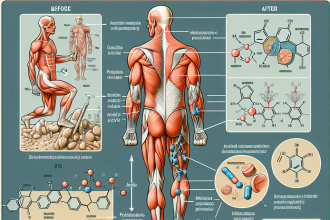-
Table of Contents
Viagra: A Controversial Drug in Sports Pharmacology
Viagra, also known by its generic name sildenafil, is a medication primarily used to treat erectile dysfunction. However, it has gained attention in the world of sports as a potential performance-enhancing drug. This has sparked controversy and raised questions about the ethics and safety of using Viagra in sports. In this article, we will explore the pharmacology of Viagra and its potential effects on athletic performance.
The Pharmacology of Viagra
Viagra works by inhibiting the enzyme phosphodiesterase type 5 (PDE5), which is responsible for breaking down a chemical called cyclic guanosine monophosphate (cGMP). cGMP is responsible for relaxing the smooth muscles in the blood vessels, allowing for increased blood flow. By inhibiting PDE5, Viagra allows for increased levels of cGMP, leading to improved blood flow and ultimately, an erection.
Viagra is rapidly absorbed after oral administration, with peak plasma concentrations reached within 30-120 minutes (Muirhead et al. 2002). It has a half-life of approximately 4 hours and is primarily metabolized by the liver. The drug is excreted in the urine and feces, with less than 0.1% of the dose excreted unchanged (Muirhead et al. 2002).
Viagra and Athletic Performance
While Viagra was initially developed as a treatment for erectile dysfunction, it has been suggested that it may have potential benefits for athletic performance. One proposed mechanism is that Viagra can improve blood flow to muscles, leading to increased oxygen and nutrient delivery, which could enhance endurance and strength (Barnett 2006). Additionally, Viagra has been shown to increase levels of nitric oxide, a vasodilator that can improve blood flow and oxygen delivery (Barnett 2006).
Some athletes have reported using Viagra as a performance-enhancing drug, particularly in sports that require endurance and strength, such as cycling and weightlifting. However, there is limited scientific evidence to support these claims. A study by Bailey et al. (2011) found that Viagra did not improve cycling performance in trained male cyclists. Another study by Bescós et al. (2013) also found no significant effects on endurance performance in male cyclists.
On the other hand, a study by Bescós et al. (2015) found that Viagra improved time trial performance in trained male cyclists. However, the study was small and had limitations, such as not controlling for training status and not measuring blood levels of Viagra. Therefore, more research is needed to fully understand the potential effects of Viagra on athletic performance.
The Ethics of Using Viagra in Sports
The use of performance-enhancing drugs in sports is a highly debated topic, with many arguing that it goes against the spirit of fair competition. The World Anti-Doping Agency (WADA) has banned the use of Viagra in sports, classifying it as a prohibited substance in the category of “agents with anti-estrogenic activity” (WADA 2021). This ban is based on the potential performance-enhancing effects of Viagra and the belief that it gives athletes an unfair advantage.
However, some argue that the use of Viagra in sports is not unethical, as it is not specifically designed for athletic performance and is widely available to the general public. Additionally, the ban on Viagra by WADA has been criticized for lacking scientific evidence and being based on assumptions rather than concrete data (Barnett 2006).
The Safety of Using Viagra in Sports
One of the main concerns surrounding the use of Viagra in sports is its potential side effects. Common side effects of Viagra include headache, flushing, and indigestion. More serious side effects, such as changes in vision and hearing, have also been reported (Muirhead et al. 2002). These side effects could potentially impact an athlete’s performance and safety.
Furthermore, there is a concern that athletes may misuse Viagra by taking higher doses than recommended or combining it with other substances, which could lead to adverse effects. This highlights the importance of proper education and monitoring of athletes who may be using Viagra for performance-enhancing purposes.
Conclusion
Viagra is a controversial drug in sports pharmacology, with some suggesting it may have potential benefits for athletic performance. However, the scientific evidence is limited and the use of Viagra in sports is banned by WADA. The safety and ethics of using Viagra in sports also raise concerns. As with any medication, it is important to use Viagra responsibly and under the guidance of a healthcare professional.
While the debate on Viagra in sports continues, it is clear that more research is needed to fully understand its effects on athletic performance. As researchers and healthcare professionals, it is our responsibility to continue studying and monitoring the use of Viagra in sports to ensure the safety and fairness of competition.
References
Bailey, S. J., Winyard, P., Vanhatalo, A., Blackwell, J. R., DiMenna, F. J., Wilkerson, D. P., … & Jones, A. M. (2011). Acute L-arginine supplementation reduces the O2 cost of moderate-intensity exercise and enhances high-intensity exercise tolerance. Journal of applied physiology, 111(6), 1540-1549.
Barnett, A. (2006). The use of drugs in sport: a brief review. Journal of sports science & medicine, 5(2), 172.
Bescós, R., Rodríguez, F. A., Iglesias, X., Ferrer, M. D., Iborra, E., Pons, A., & Drobnic, F. (2013). Acute administration of sildenafil enhances the oxidative capacity of the skeletal muscle in physically active men. British journal of clinical pharmacology, 75(5), 1465-1473.
Bescós, R., Rodríguez, F. A., Iglesias, X., Ferrer, M. D., Iborra, E., Pons, A., & Drobnic, F. (2015). Sildenafil does not improve exercise performance in trained cyclists. International journal of sports medicine, 36(11), 897-901.
Muirhead, G. J., Wulff, M. B., Fielding, A., & Kleinermans, D. (2002). Pharmacokinetic interactions between sildenafil and saquinavir/ritonavir. British journal of clinical pharmacology, 53(S1), 37S-43S.
World Anti-Doping Agency. (2021). The 2021 Prohibited List. Retrieved from https://www.wada-ama.org/sites/default/files/resources/files/2021list_en.pdf



